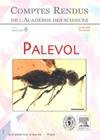欧洲大门口的狐狸祖先:Çalta-1(土耳其)的上新世狐狸及其与亚洲和欧洲上新世狐狸的关系
IF 1.3
4区 地球科学
Q3 PALEONTOLOGY
引用次数: 2
摘要
1775年在欧亚大陆的上新世Vulpes Frisch属的记录很稀少,来自几个稀疏的地方。由于缺乏全面和综合的修订,导致对许多不同分类群的描述,往往只是暂时与现存物种有关,而不是彼此相关。Çalta-1是位于土耳其安纳托利亚地区的一个重要的上新世遗址,可追溯到4.0 Ma。在本文中,我们重新评价了1998年Vulpes galatica Ginsburg的有趣记录。形态学和形态测量学证据表明,该分类群与中国榆树盆地发现的晚上新世早期北海V. Qiu & Tedford, 1990有很强的相似性。这样的证据有利于对这两个物种之间的同义关系进行简约的解释,并将其命名为北海螺。这一假说为欧亚大陆上新世-早更新世狐狸的生物地理学提供了新的解释。beihaiensis将亚洲和欧洲的记录联系起来,它与V. -alopecoides (Del Campana, 1913)有亲缘关系,最终与现存的红狐(Vulpes Vulpes (Linnaeus, 1758))有亲缘关系。本文章由计算机程序翻译,如有差异,请以英文原文为准。
Ancestral foxes at the gates of Europe: the Pliocene fox from Çalta-1 (Turkey) and their relationships with Asian and European Plio-Pleistocene foxes
The Pliocene record of genus Vulpes Frisch, 1775 in Eurasia is scarce, coming from few sparse localities. The lack of a comprehensive and integrated revision led to the description of numerous different taxa, often only tentatively related to extant species but not with one another. Çalta-1 is an important Pliocene site located in the Anatolian region of Turkey, dated to 4.0 Ma. In the present review, we reappraise the interesting record of Vulpes galatica Ginsburg, 1998. Morphological and morphometric evidence suggests a strong similarity between this taxon and the early Late Pliocene V. beihaiensis Qiu & Tedford, 1990, recovered from the Chinese Yushe Basin. Such evidence favors the parsimonious interpretation of synonymy between the two species, under the name V. beihaiensis. This hypothesis opens a new interpretation on the biogeography of the Pliocene-Early Pleistocene foxes of Eurasia. Vulpes beihaiensis links the Asian and European records, with its affinity to V. alopecoides (Del Campana, 1913) and, eventually, to the extant red fox (Vulpes vulpes (Linnaeus, 1758)).
求助全文
通过发布文献求助,成功后即可免费获取论文全文。
去求助
来源期刊

Comptes Rendus Palevol
地学-古生物学
CiteScore
2.10
自引率
0.00%
发文量
39
审稿时长
17.6 weeks
期刊介绍:
Comptes Rendus Palevol is a fully electronic and peer-reviewed journal, with a continuous publication stream, devoted to palaeontology, prehistory and evolutionary sciences. It publishes original research results, in French or English, in the following domains: systematic and human palaeontology, prehistory, evolutionary biology and macroevolution, and history of sciences. Thematic issues may also be published under the responsibility of a guest editor. All articles published in Comptes Rendus Palevol are compliant with the different nomenclatural codes. A copyright assignment will be signed by the authors before publication.
 求助内容:
求助内容: 应助结果提醒方式:
应助结果提醒方式:


